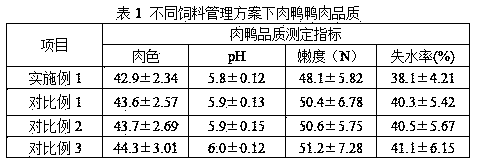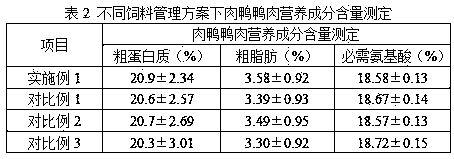Low-cost, low-pollution, high-output and high-quality type environment-friendly healthy breeding method for meat ducks
A breeding method and meat duck technology, applied in the field of agricultural livestock and poultry breeding, can solve problems such as waste of biological feed, and achieve the effects of improving the survival rate, reducing ecological pollution, and increasing the comprehensive output of the system
- Summary
- Abstract
- Description
- Claims
- Application Information
AI Technical Summary
Problems solved by technology
Method used
Image
Examples
Embodiment 1
[0026] 1. A meat duck two-low and two-high type environmental protection and healthy breeding method is characterized in that, comprising the following steps:
[0027] S1. Build a three-dimensional ecological breeding platform for meat ducks: choose waste fish ponds or original ponds with convenient transportation, sufficient water sources, good water quality, and no industrial pollution around to build a three-dimensional ecological breeding platform for meat ducks. The platform is divided into three layers, which are snails. Breeding area, fish filter feeding area and meat duck breeding area;
[0028] S2. Platform setting and clearing pond disinfection pretreatment: carry out platform setting and clearing pond disinfection pretreatment on the selected pond to be used. The specific steps are: before the pond is used, every 100m above the pond 2 The area is used as a breeding unit to build a meat duck breeding area. The breeding area is 1.1m away from the water surface, and a ...
Embodiment 2
[0033] Example 2 Feed Management Scheme Optimization Test
[0034] Adopt the method in embodiment 1, construct the three-dimensional breeding ecosystem, then the meat duck feed management scheme in S3 is set comparative ratio according to the following scheme:
Embodiment 3
[0048] Embodiment 3 Feed ratio optimization test
[0049] According to the method steps in Step S3 of Example 1, the feeds of each stage are prepared, and the ratios of the ingredients are respectively 7:1, 8:1, and 9:1, and the feeds are configured, and the configured feeds are fed separately. For 100 meat ducks in the corresponding growth stage, after the feeding period, the feed cost and weight gain of the meat ducks were counted and converted respectively. The results are shown in Table 2.
[0050]
[0051] Analyzing the data in Table 3, we found that when the ratio of basal feed to plant-based feed and basal feed to animal-based feed was 8:1, the feed cost and weight gain of meat ducks reached the best Ratio, the feed-to-meat ratio at this time is the lowest in the whole program, that is, when feeding less feed, the weight gain of meat ducks can be higher, thus achieving the breeding goal of low-cost and high-yield meat ducks.
PUM
 Login to View More
Login to View More Abstract
Description
Claims
Application Information
 Login to View More
Login to View More - R&D
- Intellectual Property
- Life Sciences
- Materials
- Tech Scout
- Unparalleled Data Quality
- Higher Quality Content
- 60% Fewer Hallucinations
Browse by: Latest US Patents, China's latest patents, Technical Efficacy Thesaurus, Application Domain, Technology Topic, Popular Technical Reports.
© 2025 PatSnap. All rights reserved.Legal|Privacy policy|Modern Slavery Act Transparency Statement|Sitemap|About US| Contact US: help@patsnap.com



